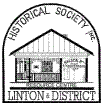|
A Brief History of Linton
|
The Linton & District Historical Society Inc. |
|
A Brief History of Linton
Linton is situated on the Springdallah Creek, 34 km south-west of Ballarat in the Golden Plains Shire, formerly the Shire of Grenville.
European settlement in the Linton area dates back to early 1840, when the Linton family arrived in Geelong from Scotland, and travelled inland on a bullock dray in search of good grazing and farming land. They took up several runs including one called "Linton Park", which was 1.5 km from the present township. The town of Linton itself was officially gazetted in 1860.
In the early mining days the area was known as "Linton Diggings" which became "Old Linton's" when the new "Linton" township was built on Surface Hill. The first gold was found in Linton Park in 1854, with some of the best finds in Happy Valley about 3.2 km from the homestead. Rich deposits were then found at Bloomer's Gully, with all the other gullys in the area being opened up in quick succession. It was estimated at the time that �500,000 worth of gold was taken from the area between 1854 and 1895. Gold mining started to decline from that point, but continued until the 1950s.
As with all the Victorian gold rushes of the 1850's, miners came from all over the world including China. In August 1856 "The Ballart Miner" reported there were not less than 1,000 Chinese on the diggings at Linton, but by the Census of 1881 only 65 were recorded as living in Linton, with a further 26 in the outlying areas. Initially many Chinese diggers worked for the large mining companies, and some established local businesses, but as the gold petered out most moved on. Those who remained turned to market gardening, which continued until the 1930s. Evidence of the many Chinese that once lived in the area can been seen in the signifcant number of graves in the Linton Cemetary.
Gold was hugely important to the development of the district, and the township became a service centre to the local mining and agricultural industries. The railway arrived in 1890, and even when mining started to decline past the turn of the 20th century, the town remained strong. Many clubs and societies were founded, together with sporting teams and a city brass band.
It was not until after WWII, with advances in mass travel and transport, that competition from larger centres began to take its toll on local business and industry. The number and diversity of local business declined, and by 1976 the rail line had closed.
At the beginning of the 21st century Linton is largely a rural community, with farming as the major industry. Community sprit remains strong, and there are still many active sports clubs, societies and groups, plus a major nature reserve and bird sanctuary.
|
